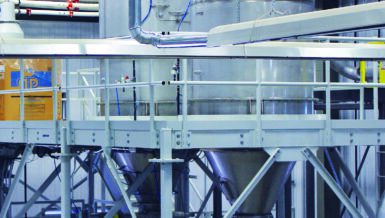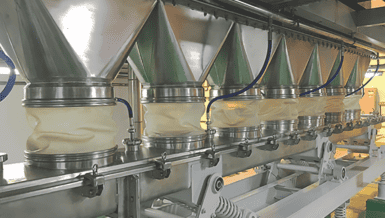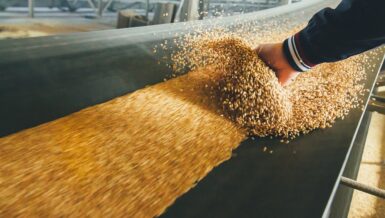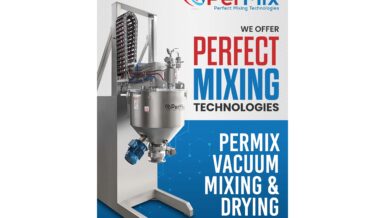A number of causes can lead to stickiness in food powders, this can happen during the production process as well as during storage. The primary cause of stickiness, of course is water. Properties like viscosity, surface tension and good solvation turn water into a catalyst for stickiness as well as caking.
In a natural situation, water is part of our atmosphere and therefore it is inherently part of our production process. When the relative humidity of the air increases so does the possibility for the moisture to adsorb on the powder surface or be absorbed by the bulk solids material. When the relative humidity levels in the room hit a certain critical level stickiness eventually followed by caking can occur even when the relative humidity is as low as 33%, as is seen in the tea and whey powder industry. The impact of moisture in the environment becomes even more important when also the temperature rises, realizing that air of higher temperature can hold more water vapor before saturation occurs.
The adsorption properties of the powder surface and the internal structure can allow water to exist as adsorbed mono/multi-layers or as capillary condensate. This can alter the micro-roughness of the surface of the food powder, inducing liquid bridges, and increasing the cohesiveness between the food particles being one of the prime causes of sticky behaviour.
Temperature
Amorphous or crystalline phases are the two general states that describe a typical solid. Using x-ray diffraction analyses, the structure of solids can be categorized into crystalline or amorphous (non-crystalline). Crystalline structures are characterized by a specific structural arrangement of atoms creating a lattice pattern. Simply put, amorphous food is a solid that lacks these specific characteristics. In the food processing industry, many of the solids can be of an amorphous nature, such as sugar, chocolate mousse, mayonnaise, and ketchup.
The physical state and molecular mobility of amorphous food solids are affected by temperature and also by composition of the food powders, which are related to the stability as well as the processability of the food powder. When looking at amorphous food solids, its most relevant attributes to handling and processing are its phase transitions capacity, its handling stability, and general processability.
Phase transitions
The state in which the amorphous solids occur depends on the movement level of the food molecules (temperature). The amorphous solids can exist in a frozen (glassy) state, or in a viscous (rubbery) state. This state of viscosity is a result of temperature and partly depends on moisture being present. The cause of viscosity in solids is because of elastic forces that arise in a solid in response to shear, like compression or extension stresses.
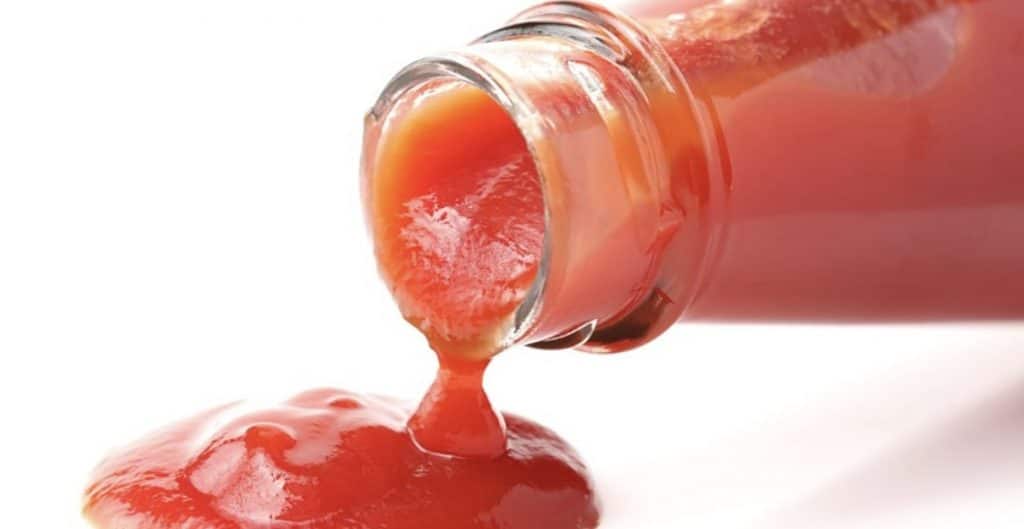
The difference between stickiness and caking
Sticky point conditions are the temperature coupled to relative humidity at which powder particles are adhered to each other, to the surface of equipment and packaging materials.
Stickiness consists of two types of stickiness, cohesive and adhesive stickiness. The attraction between similar surfaces is known as cohesive stickiness. Adhesive stickiness is the attraction between dissimilar surfaces. It is the Adhesive stickiness that creates the propensity of food powders to stick to the surface of machinery and packaging materials.
At these conditions, the food powder shows its lowest flowability level. Stickiness is a stage in which liquid bridges between powder particles are formed. Liquid bridges can occur during the production process with for example melted fats, amorphous sugars or strong sugar solutions. It is when these liquid bridges are transformed into crystal bridges through the drying process i.e. evaporation of the water, the powders enter the caking stage (spray drying for example).
Compressibility and caking
Compressibility is a measure in which the relative volume change of a sample is assessed when it undergoes a pressure change.

The combination of humidity, the right temperature as well as external compression i.e. adding a higher pressure to the material stimulates caking of food powders. Compressibility primarily happens during the storage process. The stacking of materials creates lumped or cemented materials at the bottom of the stack. Also, the factor time plays a role because caking only happens after a certain period, think of storage in a hopper or in a big bag.
DSS methods for researching stickiness
The ability to predict powder stickiness is key in preventing adhesion and adhesive forces between particles. This is not an easy feat since every product will act differently in relation to the variation in relative humidity and temperature of the environment to which the powder is exposed. The intimate relation between temperature and humidity as described makes predicting of stickiness even more difficult. Accordingly, dedicated equipment and expertise is required to study this powder stickiness behavior.
We have two main instrumental methodologies available:
- Water vapor adsorption isotherms at different temperatures and relative humidity of 0-95%. Use of the Guggenheim, Anderson, de Boer (GAB) model can help to determine the stickiness point from the isotherm at each temperature measured, although this is not always straightforward to determine.
- Powder rheometry under real-time conditions of temperature and relative humidity. Here we directly measure the stickiness point by changes in adhesive forces between particles and thus friction of the powder bed during fluidization upon changes in the powder properties. For this purpose we have greatly amended the powder rheometer to make it capable of stickiness measurement that has not been reported before. Since this stickiness measurement directly detects changes in powder flow it is highly preferred over the vapor adsorption method listed above.
The collaboration with Anton Paar in Graz, Austria to identify potential applications of the newly developed Powder Rheometer, this has led to a joined publication in which Delft University of Technology, Anton Paar, and Delft Solids Solutions worked together on stickiness assessment and a comparison has been made with the more conventional water vapor sorption measurements. (Click here to read the joined publication)
Currently, we are working on new applications of powder systems characterization by means of the Powder Rheometer; more news will follow soon.
Case situation
Delft Solids Solutions BV has used this Real-time in-situ Rheological Assessment to test cinnamon powder from a producer in Indonesia. The company was setting up a new storage facility for their cinnamon powder and they wanted to have an appropriate silo design to ensure mass flow for their product. Initially, by means of the modified powder rheometer set-up, the conditions were investigated under which their product did or did not become sticky. This is extremely relevant, especially since the weather conditions in Indonesia, in particular temperature and relative humidity are dramatically different compared to the conditions of Western Europe. Upon identifying the non-sticky regime, subsequent ring shear test measurements were executed under controlled conditions of temperature and relative humidity in a climate chamber. In this way we arrived at a suitable silo design in terms of hopper half angle and discharge opening also taking into account wall friction and consolidated bulk density.







